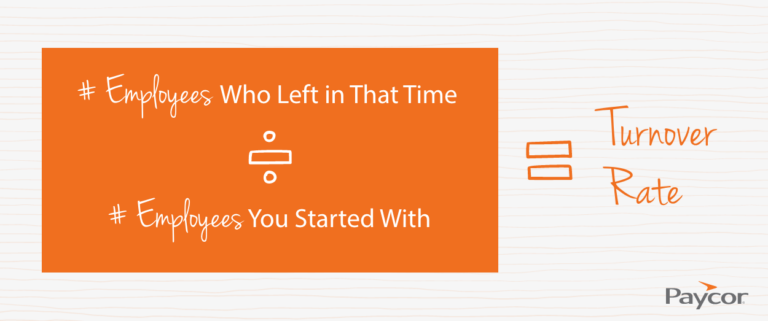On the surface, turnover seems pretty straightforward – but there’s more to it than you might think. For one thing, it’s not just the number of people who quit their jobs at your company. HR leaders need to understand the different kinds of turnover, what each one means for your company, and how to calculate turnover rates. Here’s everything you need to know.

How to Categorize Employee Turnover
Voluntary vs. involuntary turnover is just the beginning. When you’re looking at this metric, there’s a lot more nuance than that. In this article, we’ll review some of the main reasons employees leave their jobs.
| Voluntary | Involuntary | Internal | ||
| Functional | Poor performer quits | Poor performer gets fired | High performer gets promoted | |
| Dysfunctional | High performer quits | High performer gets laid off | High performer transfers away from a bad manager | |
| Retirement | Employee leaves your company to retire. HR leaders may or may not consider this to be a type of turnover. | |||
Not all turnover is bad. That’s where the idea of functional vs. dysfunctional turnover comes in. Functional turnover – voluntary or involuntary – is a sign that your HR strategy is working. Dysfunctional turnover is a warning sign.
In the current labor shortage, understanding your turnover rates is more important than ever. When you know why employees are leaving, you can make insightful decisions that move your company forward.

Voluntary Turnover
Voluntary employee turnover happens when a person decides to leave their job. With the right HR tools, this shouldn’t come as a surprise. You can use software to track key indicators that someone is considering a departure. Armed with that data, you can look for ways to entice your top talent to stay.
Functional Voluntary Turnover
An employee consistently fails to meet expectations. They’ve been with you for over a year, and it just feels like a bad fit. They get a job at another company and voluntarily leave your team.
Dysfunctional Voluntary Turnover
A high-performing employee wants to develop their career. There isn’t room for growth at your company, so they find a better job with another employer.
Involuntary Turnover
Involuntary employee turnover is when the employer decides to let someone go. Just like voluntary turnover, it can be a sign of growth, or it can mean there’s an issue with your HR strategy.
Functional Involuntary Turnover
An employee consistently shows up late, seems disengaged, and fails to meet deadlines. Worst of all, they make it clear that they’re only in it for the paycheck – they don’t care about your company’s success. The leadership team terminates their contract.
Dysfunctional Involuntary Turnover
Your company goes on a hiring frenzy, recruiting top talent in the industry. A month later, your stock plummets. The leadership team lays off several new hires, including some of your highest performers.

Internal Turnover
Internal employee turnover is when a person leaves their job for another role at the same company. When you look at internal turnover rates, make sure you review each person’s reason for switching roles. High internal turnover is often good thing – but that’s not always true.
Functional Internal Turnover
Your company is growing fast, and people are getting promoted left and right. When this happens, HR should focus on recruiting so they can fill open roles efficiently.
Dysfunctional Internal Turnover
In most departments, employees stay in the same role for several years before leaving or getting promoted. There’s one exception: everyone who works for Sally transfers out or quits within 6 months. Sally might not be a good fit for the company, or she might need help from HR to develop her leadership skills.

Retirement
Is retirement a type of turnover? It’s a surprisingly complex question. Retirement rates say less about your company culture than the other types of employee turnover. No matter how much a person loves their job, they’ll probably decide to retire eventually. On the other hand, no matter why a person stops working, HR still needs to fill the role they leave behind.
If you expect an employee to retire soon, succession planning is key. That could mean upskilling junior employees or recruiting new talent. There’s no wrong answer here, as long as you have a plan.

How to Calculate Employee Turnover Rates
Calculating your turnover rate is pretty easy. First, define a time period. Then, apply this formula:

For example, let’s say you started off the year with 100 employees. Between January and December, 4 employees quit and 6 were laid off. In that case, you’d calculate your turnover rates like this:
- Voluntary Turnover Rate: 4/100 = 4%
- Involuntary Turnover Rate: 6/100 = 6%
- Total Turnover Rate: 10/100 = 10%

The Downside of Employee Turnover
Even functional employee turnover has its downside. To put it bluntly: hiring new employees is expensive. One study found that it costs about 6-9 months of a worker’s salary to replace them (SHRM). So if an employee earns $30,000 per year, replacing them would cost at least $15k. Recruiting and training costs add up quickly.
Use our turnover calculator to see just how much employee turnover is costing your organization.
How Paycor Helps
Understanding a problem is the first step toward solving it. That’s true with anything, from a leaky faucet to dysfunctional employee turnover. HR Leaders nationwide use Paycor’s Workforce Insights to learn more about their teams – including when they’re looking for a new job. You can also survey employees to find out what they’d need to feel supported. With Paycor’s HR software, you can use data to drive retention.

Want to learn why people quit and how to make them stay? Discover tips and tools in our Turnover Guide. Get the Guide









